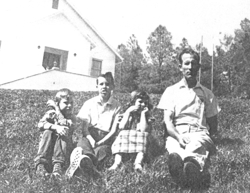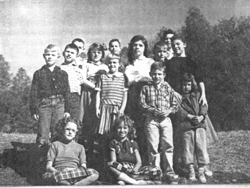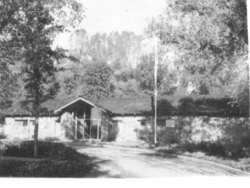MLAJA’s Early Years, 1950-1966
The first Seventh-day Adventist church was officially organized in Sonora in 1921 with eight charter members. The group met in private homes, rented halls, clubs, and churches for several years. In 1939, when their membership was about thirty, they began making plans to build their own church. In 1947 land was purchased on Hope Lane and construction began the next year. They began meeting in their unfinished church in early 1950.
That same year, 1950, Dr. Ben and Eloise Boice moved to Sonora with their two-year old son, Charles. Ben joined in medical practice with Dr. Fred Herzer and Dr. Abbott in an office located on Stockton St. He and Eloise began to think about the future when Charles and their possible future children would be ready for school. There was already a small, one-teacher school operating in the home of Mr. and Mrs. Renslow in Apple Colony, near Tuolumne. Miss Betty Canfield was the teacher, and likely the two students were the children of the Renslows. But the Boices were envisioning a church school.
Not long after the dedication of the Hope Lane church, a formal church school began with classes held in the church basement. Miss Hazel Striplin (pictured below in 1960) was the teacher in 1952, with two or three non-Adventist children. Miss Striplin only taught a few years, but she continued as an active member in Sonora for many years, celebrating her 103rd birthday here in 1996. She was still driving at age 100. Sonora member June Burson recalled in 1993 that Miss Striplin “was very firm but very understanding as a teacher. She taught my son respect as well as fractions.”

In 1953 Dr. Paul and Dr. Helen Anspach arrived in Sonora, joining the practice of Ben Boice and the other physicians. Their office was moved to Washington Street and soon became known as Sonora Hospital. The Anspachs also shared the Boice’s interest in the church school. The Anspachs and the Boices soon had three children each.
In 1954 Mr. Carl Heft came to teach a small number of children in the Sonora Church School, still located in the basement of the Hope Lane Seventh-day Adventist church. He taught for eight years. One of the first graders rode his horse to school that year, with his lunch box tied to the saddle. Dorothy Heft assisted her husband part time. Mrs. Bohmer is also mentioned as an early teacher at the new school.
In 1956 Ted and Twila Howard moved to Sonora. Ted was a young physician, and he joined the group of Adventist physicians. They had two daughters of school age, and they became strong supporters of the small school and the church. Twila contributed much to the documentation of the early school history.
In 1957 Dr. Paul and Dr. Helen Anspach and Dr. Boice built and opened Sonora Community Hospital on Forest Road in Sonora.
In 1960 three 8th graders graduated in services held in Oakdale.
This picture was taken around 1960 at the Sonora Hope Lane Church School. (Left to Right: Wally Heft, Charles Boice, Lucita Heft, and Principal/Teacher Carl Heft.)

Students at the Hope Lane school ca 1960. (Front seated: Henrietta Sandner, Aileen Howard; Standing in front right: Deanne Boice, Wally Heft, Lucita Heft; Back Row: Bill Anspach, Jimmy Sandner, unknown behind Jimmy, Margery Sandner, Chuck Boice, Caren Dittman, can’t read other names but one is probably Cathy Dittman.) (Left to Right: Chuck Boice, Bill Anspach, Deanne Boice, Aileen Howard.)

By 1960-61 the school had grown, and it was necessary for Mrs. Heft to teach full time. In June of that year two girls and one boy made up the first eighth-grade graduating class held at the new school. Charles Boice was one of the graduates.
Miss Hazel Striplin returned in 1961-1962 to teach, but became ill and could not finish the year. Mrs. Diaz finished the school year for her, and Mrs. Bohmer taught the lower grades.
The teachers in 1962-1963 were Miss Bryne and Mr. Anderson.
When the 1963-64 school year began, the two small classrooms in the basement of the Hope Lane church were bursting at the seams with 33 active students in grades 1-8. Everyone agreed, a new school was needed! The church leaders excitedly began looking for property and making plans for the new school. Two girls graduated from the 8th grade in the that school year. Their class colors were pink and white. They knew that they would probably never be able to have these colors again. They didn’t have to worry about any boys voting against them.
A beautiful site for the new school was found and soon secured. The property, located next to Sonora Community Hospital, was heavily wooded, overgrown with berry vines, and crossed by a seasonal creek. To get to the property, which had long been used as a horse pasture, you had to bump along on a rough dirt road. The creek bed and surrounding meadow were rocky and rutted from erosion, because the creek often overflowed into the whole area during heavy rainstorms.
Nearly everyone participated in the building of the new school. Church members applied their varied skills to the new building project. Many members helped clear the trees and brush off the property. Several did the laying of the blocks. Two physicians who had earned their way through college by painting, were heads of the painting crew. Others worked on the problem of rerouting and controlling the seasonal creek.
Even the school children helped. Several spent a Sunday carefully selecting just the right stones from the Peppermint Falls area for the school entry. The rocks were transported to the school, and the young people formed an “assembly” line, passing the rocks from one to another to unload them. Occasionally a rock would be dropped, causing some lively stepping to avoid having a toe smashed.
A man who was a native of Italy did the rockwork on the front of the school. A beautiful rock planter was also built inside the lobby. This was removed during the 1994 remodeling of the building.
By the fall of 1964, the two spacious schoolrooms were completed. Many happy parents and children attended the opening of the lovely new school on Forest Road next to the hospital. Mr. Green, Principal, and Miss Bryne were the first teachers in the new school.
1968 or Earlier
In 1965-66 the enrollment stood at 51 students. A third teacher, Mrs. Noel, was added to the staff. The name of the school was changed at this time to Mother Lode Academy. Later it was found that there was already a school near Ione called by the same name, so the school board voted to change the name to Mother Lode Junior Academy. The word Adventist was officially added to the name in 1972 or 1973. (This picture from ca 1965 shows the school after the 9th & 10th room was added to the east end. Notice that the west end is still the original length. The lower grades room was not added until 1969.)

During the summer of 1966 a fantastic improvement was made to the area just north of the school building. A large drainage ditch ran the entire length of the playground and kept it from being useful for field games such as baseball. The area was deepened and a concrete pipe was put into place. What a site to see that field level! Soon it was covered with grass and ready for a backstop and baseball diamond, to the delight of all the students. (Other sources indicate this playground project may have been completed after Leon Stickney arrived in 1967.)
Some interesting memories from these early years
For years before the school had a bus, parents took station wagons full of pupils on field trips, sometimes as many as 12 children in a vehicle. To cover the special insurance for these trips, the children brought 25 cents each.
For years Mrs. Boice took soup for the children’s lunches. Mr. Heft felt they should have a hot lunch.
If there was a school ground accident, the victim was hauled next door into the medical group, and one of the doctor dads would give the patient immediate care.
Ski trips started with Mr. Green in 1964. Parents took cars full of skiers.
Students came home with Brittish accents one year, obviously influenced by Miss Bryne.
When a shoebox full of horned toads got loose in the schoolroom, Miss Striplin had a time to settle the students down.
One student living above the school would go home for lunch and open all the windows and play the current hit songs loudly so the students on the playground could hear them.
Even way back in the 60s, an occasional student used to get in trouble for wearing too much makeup and talking too much.
One former student remembers being in first grade when Carl Heft was the teacher, and her brother was an eighth grader in the same classroom. There is a story about Mr. Charles Green coming to school one day in a brand new suit—the first time he had worn it. At lunch time he called a student up to his desk for something, and the student came, eating a boiled egg. Just as she came up to the desk, the student stuffed the whole rest of the egg in her mouth, where it stayed for a brief moment, until she sneezed it out all over the new suit.
While the church was being built in the mid to late 1960s, there were various piles of dirt here and there, and the story is told that the students and a former principal used to ride their bikes over them during recess. (This and the following two stories were supplied by John Mooy.)
When they were building the school in the early 60s, one of the members of the building committee really wanted to have parquet flooring installed. The other committee members didn’t want to spend the extra money to do this, but the extra money was promised so they gave in. Beautiful oak parquet was installed in the classrooms. In the early 1970s, broken water pipes soaked the floor and it buckled and looked like tents as the wood swelled. Eventually all the wood floors were replaced with carpet.
Legend has it that the rock façade on the front of the elementary building had an interesting history. A footing in the rock-hard clay was dug during the summer and the rock façade was built. When winter rains softened the clay to mush, the then lack of footing slumped under the rocks’ weight and the façade crumbled. A concrete footing was then put in to support the rocks, and the façade has looked great ever since.
Written by Janet Johnson in 2010-11
Sources: Church and school histories written years earlier by Twila Howard and Edie DeFehr, pictures in history file, interviews

